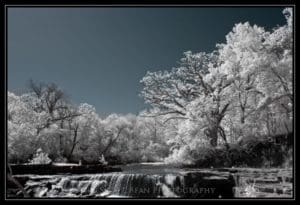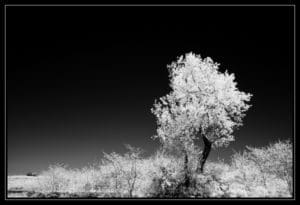
Infrared ‘season’ is about over for me…we are quickly losing all the vegetation from the trees as fall is finally taking hold. Vegetation strongly reflects IR light… combine the strong reflectance of vegetation and the dark skies of IR photos and you can get some very striking images. But as we lose a lot of vegetation from trees my IR camera won’t get much use until next spring when everything greens up again. I’ve been going through my IR photos from this past spring and summer and collected some of my favorites. These will have to tide me over until next year.
I don’t remember exactly when I fell in love with infrared (IR) photographs or exactly whose work it was that really hooked me, but hooked I am. I first started experimenting with IR photography using a Sony Cybershot that was sensitive enough to IR light that you could use a UV-VIS cutoff filter to block out all the light but the IR and get some decent photographs. It wasn’t long before I had an old DSLR converted to capture IR photographs without the need to use any filters (which honestly was a bit of a pain in the rear). Initially it was the incredibly rich black and white IR photographs that caught my eye. I loved the way the pitch black sky contrasted with the brilliant white foliage. The photograph above is one of my BW IR photos like this.
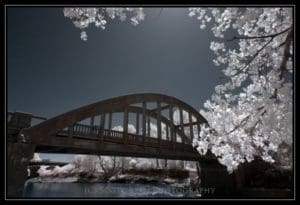
While I still like the BW IR images, I find myself keeping more of them in color and then doing a “red to blue channel swap” which puts a blue color back in the sky. I use a Photoshop action from Khromagery for this. I usually finish these photos up back in Lightroom where I will adjust the hue of the blue sky to a tone I find pleasing. I find that the sky is not blue enough for me straight from the Photoshop action. A bit of side note, if you are processing RAW IR photos I would highly recommend creating a dedicated camera profile for this. Khromagery has a great article on this.
I really like the look of IR photographs with the blue sky and the white foliage. I do find that after the ‘red to blue swap’ the foliage will sometimes take on a slight reddish cast. I will often desaturate this in Lightroom using the adjustment brush.
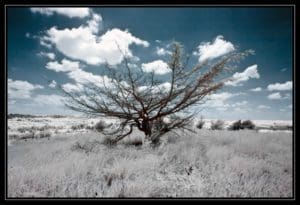
One thing I really enjoy about IR photography is that you need some sunlight to really make the foliage sing which means shooting earlier in the day than I normally would. So an added bonus when carrying an IR camera is to extend my shooting time!
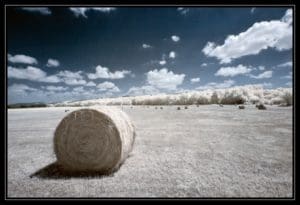
Another thing I really like about IR photography is that no matter how good I get at visualizing how a traditional color landscape might turn out in a photograph, you are never quite sure how a scene is going to turn out in IR. Each photograph is a surprise (some good and some not so good). I didn’t expect the photo above of the hay bales to turn out very well but I really liked this one.
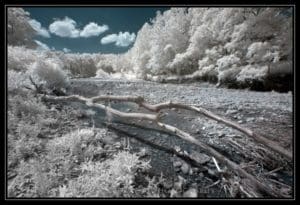
This next photograph was also one of my favorites from this past summer. This was taken pretty early in the afternoon (3:30ish in June) and I probably would have never considered shooting a traditional color photograph of this scene at that time of day. I think the IR photo came out very well though.
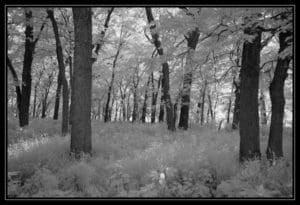
While the sky in IR photos is almost always very striking, that doesn’t mean you have to include it in every IR photo. I’ve noticed that I make a lot of IR photos that isolate tree trunks against foliage. I think I like the contrast of the dark tree trunks against the white foliage.
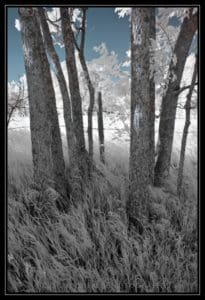
Of course combining tree trunks, foliage and sky also results in a nice photograph!
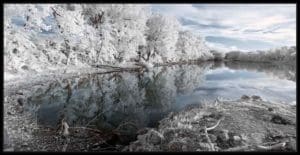
Something I don’t think of very often for some reason is making IR panoramic photos. I almost always like the results so I need to work on remembering to do this more often. This pano was made at Willow Lake below the Tuttle Creek Lake dam. This has been a great spot for IR photos. Lots of interesting trees, it is protected so the lake surface is usually still and you get some great late afternoon light.
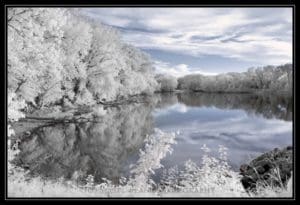
This next photo was also made at Willow Lake the same afternoon as the pano above. This last photograph is probably my favorite from this year’s IR shots. I’m sure I will be back at this location next spring and summer with my IR camera.
IR photography is a lot of fun. If you have an old DSLR sitting around that you aren’t using you should consider converting it for IR. Conversions aren’t cheap but I’ve read that prices are dropping so now might be a good time to consider converting a camera. Having the opportunity to ‘see’ the world in IR light does open up a whole new world to photograph!

